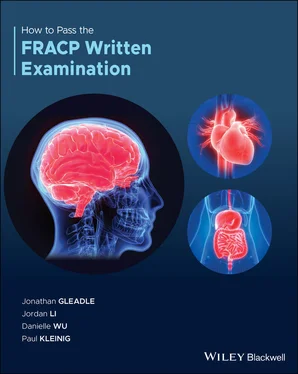Citrate, a metabolite in the Krebs cycle, has been linked to fatty‐acid synthesis and protein acetylation, which is important for macrophage and dendritic cells activation. Macrophages and dendritic cells play important roles in the innate immune system as the first line of defence against pathogens by producing inflammatory mediators, phagocytosis of pathogens, and releasing chemokines to recruit other inflammatory cells to the site of infection. Dendritic cells are also antigen presenting cells and play an important role in the adaptive immune response.
Itaconate is derived from citrate and has a direct antibacterial effect and is an important immunomodulator.

Williams N, O’Neill L. A Role for the Krebs Cycle Intermediate Citrate in Metabolic Reprogramming in Innate Immunity and Inflammation. Frontiers in Immunology. 2018;9.
https://www.frontiersin.org/articles/10.3389/fimmu.2018.00141/full
15. Answer: C
Multiple endocrine neoplasia (MEN) is characterised by the occurrence of tumours involving two or more endocrine glands. There are four major forms of MEN ( Table 4.1), which are autosomal dominant disorders.
Table 4.1 Four major forms of MEN with their characteristics and associated genetic abnormalities.
| Syndrome |
Gene mutation |
Encoded protein |
Clinical criteria |
| MEN1 |
MEN1 (tumour suppressor gene) mutation |
Mentin |
Parathyroid, pancreatic islet and anterior pituitary tumours |
| MEN2 (MEN2A) |
Rearranged during transfection ( RET ) mutation |
Tyrosine kinase receptor |
Medullary thyroid carcinoma (MTC) in association with phaeochromocytoma and parathyroid tumours |
| MEN3 (MEN2B) |
RET mutation |
Tyrosine kinase receptor |
MTC and phaeochromocytoma in association with a marfanoid habitus, mucosal neuromas, medullated corneal fibrese and intestinal autonomic ganglion dysfunction, leading to megacolon |
| MEN4 |
CDNK1B mutation |
Cyclin‐dependent kinase inhibitor |
Parathyroid and anterior pituitary tumours in possible association with tumours of the adrenals, kidneys, and reproductive organs |
RET ( ‘ rearranged during transfection) ’ is located on chromosome 10 (10q11.2) and contains 21 exons. The RET proto‐oncogene encodes a receptor tyrosine kinase for members of the glial cell line‐derived neurotrophic factor family of extracellular signalling molecules. ‘Loss of function’ RET mutations are associated with the development of Hirschsprung's disease, while ‘gain of function’ germline mutations are associated with the development of various types of human cancers, including medullary thyroid carcinoma, MEN type 2A and 2B, phaeochromocytoma and parathyroid hyperplasia.
MEN2A is characteriseds by MTC, phaeochromocytoma and primary hyperparathyroidism. If MEN2A is suspected, the RET gene should be examined for an underlying mutation. Autosomal dominant inheritance of MEN2 means that the offspring of an affected person has a 50% chance of inheriting the mutated gene. Identification of the underlying genetic mutation also allows predictive testing in relatives, monitoring for early detection of disease in mutation carriers, and reassurance for non‐carriers.
Von Hippel‐Lindau (VHL) gene mutation is associated with renal cell cancer, phaeochromocytoma, retinal angioma and haemangioblastoma.

McDonnell J, Gild M, Clifton‐Bligh R, Robinson B. Multiple endocrine neoplasia: an update. Internal Medicine Journal. 2019;49(8):954–961.
https://onlinelibrary.wiley.com/doi/full/10.1111/imj.14394
16. Answer: D
Maturity‐onset diabetes of the young (MODY) is a group of inherited, non‐autoimmune diabetes which usually present in adolescence or young adulthood. It is caused by single gene mutations related to beta cell development, regulation, and function. These defects lead to impaired glucose sensing and insulin release. MODY should be suspected in patients with early‐onset diabetes in adolescence or young adulthood (typically age <35 years). They usually have atypical features for both type 1 and 2 diabetes.
Features atypical for type 1 diabetes:
Absence of pancreatic islet autoantibodies
Evidence of endogenous insulin production
Measurable C‐peptide in the presence of hyperglycemia
Low insulin requirement for treatment (<0.5 U/kg/day)
Lack of ketoacidosis when insulin is omitted from treatment.
Features atypical for type 2 diabetes:
Onset of diabetes before age 45 years
Lack of obesity (unless south‐east Asian ethnicity, where type 2 diabetes occurs at lower BMIs)
Normal triglyceride levels and/or HDL‐C
Mild, stable fasting hyperglycemia that does not progress or respond appreciably to pharmacologic therapy
Extreme sensitivity to sulfonylureas.
Ketonuria is often seen in type 1 diabetes especially when the patient develops DKA. However, it can occur in MODY during other complications such as sepsis, acute myocardial infarction, excessive alcohol intake, and prolonged fasting and is therefore not a useful test to differentiate between type 1 diabetes and MODY.
There are at least 14 genes that are associated with MODY. The four most common causes of MODY are the following: GCK‐MODY (MODY2) and HNF1A‐MODY (MODY3), each accounting for 30%–60% of all MODY. While HNF4A‐MODY (MODY1) and HNF1B‐MODY (MODY5), together account for about 10% of all MODY. Approximately 20% of all MODY has been attributed to pathogenic variants in ten other genes.
Establishing a specific genetic cause of MODY can help in management of the proband, genetic counseling of family members, and medical surveillance of at‐risk family members. Moreover, in certain cases, it can also assist in optimising diabetes therapy. A MODY multigene panel that includes the 14 known MODY‐related genes and other genes of interest is most likely to identify the genetic cause of MODY at the most reasonable cost while limiting identification of variants of uncertain significance and pathogenic variants in genes that do not explain the underlying phenotype.

Bishay R, Greenfield J. A review of maturity onset diabetes of the young (MODY) and challenges in the management of glucokinase‐MODY. The Medical Journal of Australia. 2016;205(10):480–485.
https://www.mja.com.au/journal/2016/205/10/review-maturity-onset-diabetes-young-mody-and-challenges-management-glucokinase
17. Answer: A
Paget's disease of bone (PDB) is a non‐malignant bone disease, characterised by abnormal bone remodelling at one or multiple sites. Increased osteoblast activity leads to increased bone formation which is paired with increased osteoclast activity. Although bone formation is increased, it is disorganised, mechanically weak, and prone to deformity and fractures. Risk factors of PDB include increasing age, male sex (1.4:1), and certain ethnicities (most commonly in Caucasians). Genetic mutations in the SQSTM1 gene, are identified in up to 50% patients with a family history of PDB and in 5–10% of patients without a family history of PDB. This genetic mutation impairs the ability of p62 to bind ubiquitin, leading to activation of receptor activator of nuclear kappa B ligand (RANKL)‐induced NF‐kB which increases the osteoclast activity.
Читать дальше















